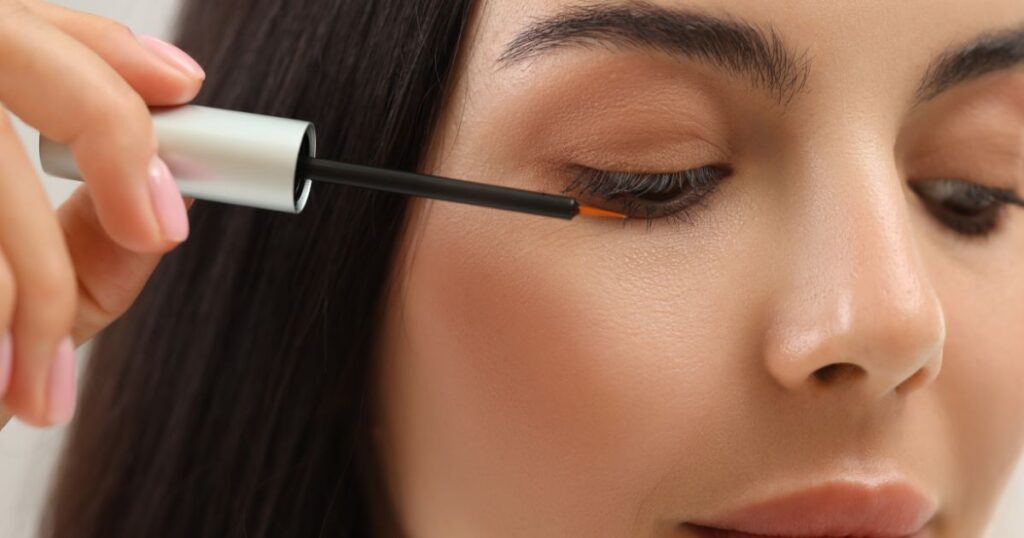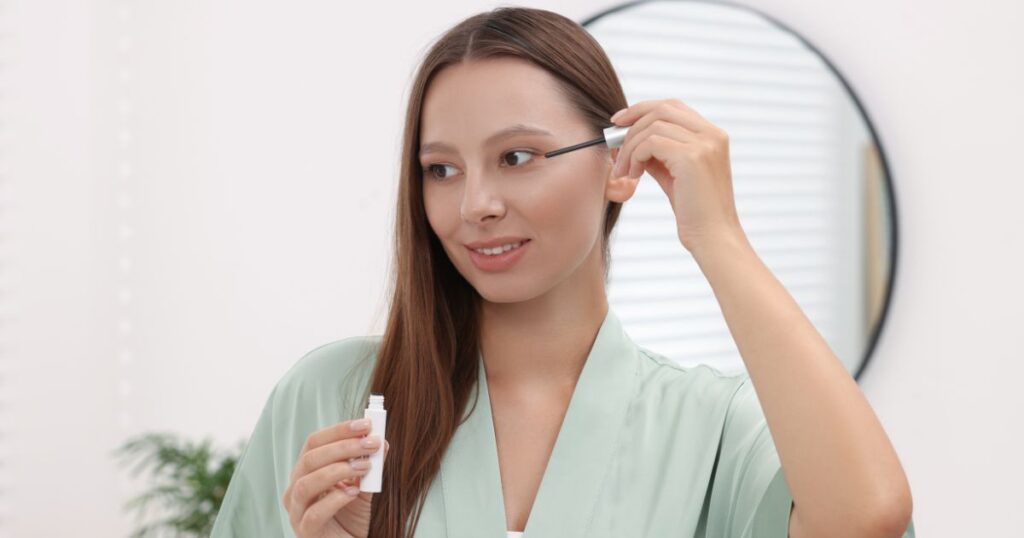In the pursuit of longer, thicker eyelashes, many turn to natural remedies, with castor oil being a popular choice. But does castor oil help eyelash growth, or is it simply a myth? Let’s dive deep into the heart of the debate, exploring the efficacy, benefits, and potential risks of using castor oil on your eyelashes.
Table of Contents - Click to Go
What is Castor Oil?
Castor oil, extracted from the seeds of the Ricinus communis plant (castor oil plant), has been revered for its medicinal and cosmetic benefits for centuries. Its history is as rich as its oil, spanning across civilizations that believed in its potent healing properties.
- Ancient Egyptian Use: Castor oil was used in lamps, as an offering to the gods, and even in beauty treatments by the Egyptians.
- Traditional Medicine: Across the world, from India to the Mediterranean, castor oil has been a staple in treating ailments ranging from skin conditions to digestive issues.
The leap from traditional medicine to beauty regimes isn’t far-fetched. Castor oil’s rich fatty acid content, particularly the ricinoleic acid found in Jamaican black castor oil, is thought to be the magic behind its purported benefits.
These include:
- Moisturizing dry skin
- Reducing acne
- Promoting hair growth
It’s this last point—hair growth—that has sparked interest in its effects on eyelashes. The theory goes that if castor oil can promote hair growth on the scalp, then perhaps it can do the same for eyelashes, making them longer and fuller.
What Does Research Say About Castor Oil for Eyelash Hair Growth?

When it comes to beauty and health claims, turning to science provides us with a clearer picture. Pure castor oil, despite its long history of anecdotal success, has been the subject of relatively few scientific studies regarding its effect on hair growth, particularly eyelashes.
The Role of Ricinoleic Acid
At the heart of castor oil’s purported hair growth benefits is ricinoleic acid, a type of fatty acid that makes up a significant portion of the oil.
Here’s what research suggests about ricinoleic acid:
- Promotes Scalp Health: Ricinoleic acid has anti-inflammatory properties, which may help in maintaining a healthy scalp, potentially creating a conducive environment for hair growth.
- Enhances Circulation: There’s some evidence that ricinoleic acid can improve blood circulation to the scalp, possibly supporting hair growth by nourishing the hair follicles.
Can Castor Oil Help Lash Growth?

While the properties of ricinoleic acid suggest potential benefits for hair growth, direct evidence linking castor oil and its fatty acids to increased eyelash length or thickness is sparse.
Here’s what the scientific landscape looks like:
- Limited Research: Most studies focus on scalp hair growth, with minimal research specifically targeting eyelashes.
- Anecdotal Reports: Many users report positive results, but these testimonials lack the control and rigor of scientific experiments.
- Need for Further Studies: Experts agree that more research is needed to conclusively determine castor oil’s effectiveness for eyelash growth.
Despite the lack of concrete scientific evidence, the anecdotal success stories and the understanding of ricinoleic acid’s properties keep the interest in castor oil for eyelashes alive.
It’s important for individuals to weigh the scientific findings (or lack thereof) against the anecdotal evidence when considering castor oil for eyelash enhancement. We always lean on the side of scientific evidence.
Choosing the Right Pure Castor Oil For Eyelash Growth
If, after examining the research for yourself, you want to try castor oil for eyelash growth, here are a few factors to keep in mind.
- Organic Certification: Look for castor oil that’s certified organic. This ensures the oil is extracted from plants grown without the use of pesticides or chemical fertilizers, reducing the risk of skin irritation.
- Cold-Pressed: Opt for cold-pressed castor oil. This extraction method doesn’t involve heat, which means the oil retains its natural nutrients and enzymes, potentially enhancing its effectiveness.
- Hexane-Free: Ensure the castor oil is hexane-free. Hexane is a solvent used in some extraction processes, but it can be harmful if residues are left in the product.
- Transparent Labeling: Good quality castor oil will have clear, transparent labeling that includes its origin, extraction method, and any certifications. This transparency is a good indicator of a reputable product.
- Packaging: Prefer castor oil in dark glass bottles. Light can degrade the oil’s quality, and glass is preferable over plastic to avoid leaching chemicals.
Application Tips

Once you’ve selected the right castor oil, following the correct application method is crucial for safety and to potentially increase the chances of seeing results:
1. Patch Test: Before applying castor oil to your lash line, do a patch test on your skin to ensure you’re not allergic to it.
2. Cleanse: Always start with clean, makeup-free eyelashes to ensure the oil can penetrate effectively.
3. Apply Sparingly: Use a clean eyeliner brush or cotton swab to apply the oil gently to the lash line. A little goes a long way, and you want to avoid getting the oil into your eyes. If you’re using hydrogenated castor oil (a solid form of castor oil), rub it between your fingers until it begins to melt, then run it along your lash line.
Choosing the right castor oil and applying it correctly can make a difference in your experience and the results you see. While the scientific evidence on castor oil for eyelash growth might be limited, ensuring you’re using a high-quality product in the safest way possible is key.
Are There Side Effects of Using Castor Oil For Eyelash Growth?
While castor oil is natural and widely used for various beauty treatments, it’s not without its potential drawbacks. Understanding these risks can help you make an informed decision and use the product safely.
Allergic Reactions
Even natural products can cause allergic reactions in some individuals. Symptoms of an allergic reaction to castor oil may include:
- Redness
- Itching
- Swelling around the eyes
If you notice any of these symptoms after applying castor oil, discontinue use immediately and consult a healthcare provider if necessary.
Eye Irritation and Other Concerns
Applying castor oil too close to the eye or in excessive amounts can lead to irritation, especially if the oil enters the eye. Potential issues include:
- Blurred vision
- Discomfort or burning sensation
- Temporary clouding of vision
To minimize the risk of irritation, apply castor oil carefully using a clean applicator and avoid overuse.
Blockage of Oil Glands
Though less common, there’s a possibility that excessive use of castor oil on the eyelashes could lead to the blockage of the oil glands around the eyelids. This could potentially result in conditions such as styes or blepharitis (inflammation of the eyelid).
Note: this is also true with other natural types of oils that are commonly used on the eyelashes, such as coconut oil, vegetable oil, or olive oil.
Safety Precautions
To mitigate these potential risks, consider the following safety precautions:
- Always test castor oil with a patch test on your hand or wrist before using it around the eyes.
- Use a clean, precise applicator to avoid getting the oil directly in your eyes.
- Start with a small amount of oil to assess your tolerance.
Remember, while many find castor oil to be a harmless and beneficial addition to their beauty routine, individual reactions vary. Listening to your body and proceeding with caution is paramount.
Alternative Clean Beauty Methods for Eyelash Growth
While castor oil is a popular natural remedy for eyelash enhancement, it’s not the only path to fuller, longer lashes. Here are some alternative methods that have gained popularity:
Nutritional Support
Believe it or not, what you eat can impact your eyelashes. Incorporating foods rich in vitamins and minerals that support hair growth can contribute to healthier hair follices and help lashes grow. Key nutrients include:
- Biotin: Found in eggs, nuts, and whole grains, biotin supports keratin production, a protein crucial for hair health.
- Vitamin E: An antioxidant that can enhance blood circulation to hair follicles, available in avocados, spinach, and almonds.
Eyelash Serums
There are numerous eyelash serums on the market designed to promote lash growth. When selecting a serum, consider the following:
- Ingredients: Look for a natural lash serum that includes peptides, biotin, and natural extracts known to support hair growth, like this one from LashLuxury.
- Safety: Choose products that have undergone ophthalmologist testing to ensure they’re safe for use around the eyes.
Gentle Care and Maintenance
Sometimes, the key to longer lashes lies in how you treat them. Simple changes in your beauty routine can make a difference:
- Be Gentle: Avoid rubbing your eyes harshly and be gentle when removing eye makeup to prevent lash breakage.
- Limit False Lashes: Frequent use of false lashes and harsh adhesives can weaken your natural lashes over time.
Professional Treatments
For those seeking more dramatic results, professional treatments can be an option:
- Lash Extensions: Applied by a professional, extensions add length and volume but require regular maintenance.
- Lash Lift: A semi-permanent treatment that curls your natural lashes, giving the appearance of length and volume.
Prescription Solutions
In some cases, a dermatologist might prescribe a lash growth treatment. These are typically more potent and come with a greater risk of side effects, so they should be considered carefully and used under medical supervision.
The Verdict is Still Out on Whether Castor Oil Helps Eyelash Growth

While the scientific evidence specifically supporting castor oil’s effectiveness for eyelash growth is limited, its long history of use for beauty and health purposes, combined with anecdotal success stories, keeps it in the conversation.
Ultimately, the best approach is the one that aligns with your personal health, beauty preferences, and comfort level. Whatever method you choose, prioritizing the health and safety of your eyes and eyelashes is paramount.
- Castor Oil is simply not proven to grow eyelashes. This is the basic fact at this time. Choosing to try it out or not is a personal decision.
- Castor Oil’s Rich History: Castor oil has been used for centuries in traditional medicine and beauty, suggesting its enduring appeal and potential benefits.
- The Role of Ricinoleic Acid: Ricinoleic acid, a major component of castor oil, is known for its anti-inflammatory and possibly hair growth-promoting properties, though direct scientific evidence on eyelash growth is limited.
- Choosing Quality Matters: For those interested in trying castor oil, selecting a high-quality, organic, cold-pressed, and hexane-free product is crucial for safety and efficacy.
- Awareness of Risks: While natural, castor oil can cause allergic reactions or eye irritation in some individuals, highlighting the importance of a patch test and cautious application.
- Alternatives Abound: Besides castor oil, there are various other methods for eyelash growth, including nutritional support, eyelash serums, gentle care, and professional treatments, catering to different preferences and needs.
Informed Decisions: Ultimately, choosing a method for enhancing eyelash growth should be based on personal research, safety considerations, and, if necessary, consultations with healthcare professionals.

